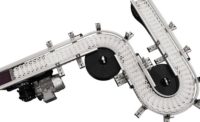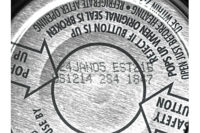Vision systems can help manufacturers reduce scrap, increase yield and discover better ways to assemble products.
Vision systems can also tell you where items are in production, and they can ensure that parts are in the right place at the right time. No more wondering: Is a part present? Is it in the right orientation? Is it the right diameter and shape? Is it the right color?
One company uses vision in a simple sorting application. The system reads a bar code on the product and directs a machine to drop it into the appropriate box. The system makes sure the right products go into the right box, and that each box gets the right mailing label.
Camera Choices
Cameras for vision systems are not like consumer or commercial video cameras. They’re designed for industrial environments. Producing high-quality products requires high-quality equipment. Unlike most consumer cameras, most machine vision cameras are equipped with charge-coupled device (CCD) sensors rather than complementary metal oxide semiconductor (CMOS) sensors. CCDs produce less noise, have a wider dynamic range, and are more sensitive to light.
Although early cameras were analog, most of today’s cameras are digital. Since the analog days, resolution and quality have improved dramatically. Analog consisted of National Television System Committee (NTSC), phase alternating line (PAL) or sequential color with memory (SECAM) video with a resolution of approximately 0.33 megapixel. Analog video required interlacing: Each frame consisted of only the even rows or odd rows of an image, and frames had to be stitched together.
Today, digital cameras can process more data and are available with resolutions of up to 29 megapixels. Some digital cameras can be networked in point-to-multipoint topologies. Analog cameras are limited by simple camera-to-computer connectivity. That won’t work for complex 3D inspection, which requires multiple cameras to work closely in sync.
Camera specifications and types are determined by lighting, inspection speed, total area, and whether the object is stopped or moving. Other factors include total data rate, distance to the computer, and whether color values are needed. The camera’s field of view, the size of the object, the size of the defect, and the distance from the camera to the inspection area determine the camera’s resolution, the lens’ field of view—the area that the camera needs to see—and the working distance, or how close the camera must be to the item being inspected.
Generally, smaller defects require higher resolution, but higher resolution sensors will likely have lower frame rates. Faster moving objects need faster frame rates and camera outputs, determined by the total data rate from the camera: resolution x frame rate x bit depth. Digital cameras provide several output options, such as GigE, Camera Link, CoaXPress and High-Definition Serial Digital Interface (HD-SDI). Most digital cameras also have a range of bit-depth options, which helps when finding defects in both high-contrast and low-contrast environments.
Most vision systems use monochrome, not color, sensors. Monochrome sensors provide sensitivity to wavelengths beyond just visible light. For example, monochrome cameras may also be sensitive to near-infrared and ultraviolet light. These wavelengths can be used to see through plastic packaging or detect thermal effects in solar panels. Color cameras are used when detecting color changes is important, such as recognizing abnormalities in food. However, storing color images requires more memory and processing power.
Camera interface standards affect bandwidth, system configurations and cable lengths. Operating at 1 gigabyte per second (Gbps), GigE Vision accommodates cable lengths of 100 meters. Camera Link’s 6-Gbps maximum speed requires two cables, each of which is limited to 10 meters long. CoaXPress delivers 6.25 Gbps per cable over 40 meters or 3.125 Gbps over 100 meters. Since it relies on coax cables, like analog cameras, CoaXPress only allows point-to-point topologies.
After deciding these specifications, engineers can consider differences in camera quality. For example, the cost difference between a camera that produces some visual noise, and one with the same specs that produces none, can be only 5 percent to 10 percent. Noise levels affect the accuracy of the vision system. They can produce false positives or false negatives (missed defects). So before picking a camera, engineers should consider the noise levels of various cameras and decide what is acceptable in their particular application. Can some noise be tolerated?
Since heat in the sensor is the main cause of visual noise, engineers should determine how much heat the sensor dissipates and how hot the camera gets. A camera is only as good as its components. Industrial-grade CCD cameras have an operating temperature range of -40 to 85 C, which is much wider than the 0 to 70 C range of commercial-grade components.
Once engineers have picked a camera, they need to consider the system configuration. Where will the cameras be located? How much space is available? How will the parts be illuminated? Cable lengths are determined by the distance between camera and computer. In industrial applications, they can’t always be side by side. Longer cable lengths are provided by some camera interface standards, such as CoaXPress and GigE.
Sometimes there isn’t enough space for a separate power cable for the camera. One solution is a camera equipped with Power over Ethernet or Power over Camera Link. By carrying power and data over a single cable, these interfaces let engineers wire cameras into hard-to-reach areas.
The number and type of cameras needed depend on the goal of the vision system. Will the system be inspecting moving objects from similar angles with parallel cameras? Or will the system be inspecting stationary objects from different angles?
The system configuration and the data being gathered determine lighting requirements. Is the system looking for a specific defect, recognizing a particular pattern, or measuring an object? How much uniformity, contrast or brightness is necessary? How much power consumption and heat generation does the application allow? The answers will help determine whether you choose LEDs, halogen lamps, fiber optics, or a combination of lighting technologies.







